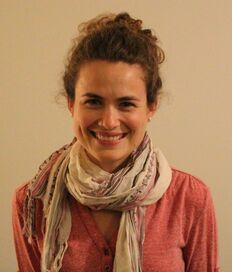Cassidy D’Aloia
PhD Student (2010 – 2015)

- Title PhD Student
(2010 – 2015) - Office 3
- Education BA Hons, Middlebury College
Originally from upstate New York, Cassidy received her B.A. in Biology from Middlebury College in Vermont. Her undergraduate research focused on using population genetic data and coalescent modeling to study lamprey population dynamics. In the Buston Lab, she used the neon goby Elacatinus lori as a model system to investigate marine larval dispersal and population connectivity, applying direct and indirect genetic techniques, GIS analyses and simulation modeling. Cassidy is broadly interested in population ecology, metapopulation modeling and genetics, and marine conservation. On graduating from the BU, Cassidy did one postdoc with Marie-Josée Fortin at the University of Toronto and another with Mike Neubert at the Woods Hole Oceanographic Institution, before becoming a faculty member at the University of New Brunswick in Canada.
Lab Publications (Google Scholar Profile)
D’Aloia, C. C., Andres, J. A., Bogdanowicz, S. M., McCune, A. R., Harrison, R. G. & Buston, P. (2020) Unraveling hierarchical genetic structure in a marine metapopulation: a comparison of three high-throughput genotyping approaches. Molecular Ecology 29: 2189-2203.
Lesneski, K. C. D, D’Aloia, C. C., Fortin, M-J. & Buston P. M. (2019) Disentangling spatial distributions of a sponge-dwelling fish and its host sponge. Marine Biology 166: 66
Shaw, A., D’Aloia, C. C. & Buston, P. M. (2019) The evolution of marine larval dispersal kernels in spatially structured habitats: analytic models, individual-based simulations, and comparisons with empirical estimates. American Naturalist 193: 424-435.
D’Aloia, C. C., Xuereb, A., Fortin, M-J., Bogdanowicz, S, M. & Buston, P. M. (2018) Limited dispersal explains the spatial distribution of siblings in a reef fish population. Marine Ecology Progress Series 607: 143-154.
Majoris, J. D, D’Aloia, C. C. D, Francis, R. U & Buston, P. (2018) Differential persistence favors habitat preferences that determine the distribution of a reef fish. Behavioral Ecology 29: 429-439.
D’Aloia, C. C. D, Bogdanowicz, S. M., Harrison, R. G. & Buston, P. M. (2017) Cryptic genetic diversity and spatial patterns of admixture within Belizean marine reserves. Conservation Genetics 18: 211-223.
Schmiege, P. U, D’Aloia, C. C. D & Buston, P. M. (2017) Anemonefish personalities influence the strength of mutualistic interactions with host sea anemones. Marine Biology 164: 24-
D’Aloia, C. C. D, Bogdanowicz, S. M., Francis, R. K. U, Majoris, J. D, Harrison, R. G. & Buston, P. (2015) Patterns, causes and consequences of marine larval dispersal. Proceedings of the National Academy of Sciences, USA 112: 13940-13945.
D’Aloia, C. C. D, Bogdanowicz, S. M., Harrison, R. G. & Buston, P. M. (2014) Seascape continuity plays an important role in determining spatial genetic structure in a coral reef fish. Molecular Ecology 23: 2902-2913.
D’Aloia, C. C. D, Bogdanowicz, S. M., Majoris, J. E. D, Harrison, R. G. & Buston, P. M. (2013) Self-recruitment in a Caribbean reef fish: a new method for approximating dispersal kernels. Molecular Ecology 22: 2563-2572
Buston P. M. & D’Aloia, C. C. D (2013) Marine Ecology: Reaping the benefits of local dispersal. Current Biology 23: R351-R353.
D’Aloia, C. C. D, Majoris, J. E. D & Buston, P. M. (2011) Predictors of the distribution and abundance of a tube sponge and its resident goby. Coral Reefs 30: 777-786.